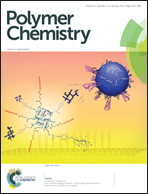Combining the incompatible: Block copolymers consecutively displaying activated esters and amines and their use as protein-repellent surface modifiers with multivalent biorecognition†
Abstract
We present the facile synthesis and orthogonal functionalization of diblock copolymers containing two mutually incompatible segments, i.e. primary amines and activated esters, that are displayed chronologically and synthesized by consecutive radical addition fragmentation transfer polymerization (RAFT) of suitably modified monomers. Post-polymerization modification of the active ester moieties with functionalized triethylene glycol derivatives (TEG-NH2/BiotinTEG-NH2) furnishes a protein-repellent block with specific biorecognition, and the activation of the amine groups via deprotection results in newly reactive primary amines. We subsequently use these amines as an anchoring layer for the coating of aldehyde-functionalized polystyrene (PS) colloids and demonstrate tight adhesion and enhanced protein-repellent characteristics combined with specific and multivalent biorecognition of avidin as a function of block ratios. Our strategy demonstrates a viable approach for orthogonal combination of widely needed, but mutually incompatible, functional groups into complex polymer architectures.


 Please wait while we load your content...
Please wait while we load your content...